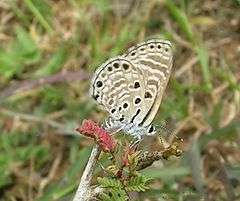Azanus jesous
| African Babul Blue | |
|---|---|
 | |
| Laying eggs on Mimosa pudica. Mudumalai, India. | |
| Scientific classification | |
| Kingdom: | Animalia |
| Phylum: | Arthropoda |
| Class: | Insecta |
| Order: | Lepidoptera |
| Family: | Lycaenidae |
| Genus: | Azanus |
| Species: | A. jesous |
| Binomial name | |
| Azanus jesous (Guérin, 1847)[1] | |
| Synonyms | |
| |
The African Babul Blue or Topaz-spotted Blue[2] (Azanus jesous) is a small butterfly found in India and Africa that belongs to the Lycaenids or Blues family.
Description
_mating_in_Vanasthalipuram%2C_Hyderabad%2C_AP_W_IMG_9424.jpg)
Male upperside a paler and much brighter purple than in A. ubaldus, the dark blue tint at the base of the wings more pronounced. Fore wing: without the clothing of specialized hair-like scales so conspicuous in ubaldus. Hind wing: with the dark tornal spots very obscure. Fore and hind wings: with only slender dark anticiliary lines, but no regular brown edging. Underside: dull pale grey. Fore wing: costal margin brown, a black white-encircled spot in cell, a dark chestnut-brown streak between vein 12 and subcostal vein; similarly coloured but somewhat paler transverse bars cross the upper discal area of the wing as follows: one on the discocellulars and three beyond, each bar edged internally and externally with white; below this two elongate brownish white-edged spots placed en echelon and beyond a slender, unbroken, transverse, postdiscal brown line; a transverse subterminal series of black spots, each surrounded with white, and a slender anticiliary dark line. In most specimens there is also a dusky spot below the cell near the base of the wing.
_I_IMG_6389.jpg)
Hind wing: an outwardly oblique short streak from base of cell, a spot below it, a transverse subbasal series of four spots and a complete series of subterminal spots in interspaces 1, 2, 4, 5, 6, and 7, jet-black, each spot surrounded with white; the sub-terminal spot in interspace 3, a terminal small spot in interspace 7, an outwardly-oblique discal line of six elongate spots, the anterior spot shifted inwards out of line, and a transverse line beyond apex of cell, dark brown, each of these markings margined with white; on the terminal area there is an inner subterminal lunulated dark line on the inner side of the Beries of black spots and an anticiliary similar slender line. Cilia white, basal halves brown ; on the fore wing interrupted also with brown at the apices of the veins. Antennae, head, thorax and abdomen dark brown; shafts of the antennas white-ringed, thorax with a little bluish pubescence; beneath: palpi, thorax and abdomen white.
Female upperside: milky brown, bluish at the base of the wings. Fore wing: a large dark brown discocellular transverse spot and a small quadrate white patch beyond. Hind wing: some two or throe obscure dark sub-terminal spots towards the tornus. In some specimens the series complete from apex to tornus, more obscure anteriorly than posteriorly. Fore and hind wings: both with slender dark anticiliary line. Underside: ground-colour slightly paler, but the markings very similar to those in the male; the transverse brown bars beyond apex of cell on the fore wing longer, almost extended to the dorsal margin. Cilia, antennae, thorax and abdomen much as in the male.[3]
References
- ↑ Azanus, Site of Markku Savela
- ↑ Woodhall, Steve. Field Guide to Butterflies of South Africa, Cape Town:Struik Publishers, 2005.
- ↑ Bingham, C. T. 1907. Fauna of British India. Butterflies. Volume 2
See also
| Wikimedia Commons has media related to Azanus jesous. |
_in_Vanasthalipuram%2C_Hyderabad%2C_AP_W_IMG_9403.jpg)